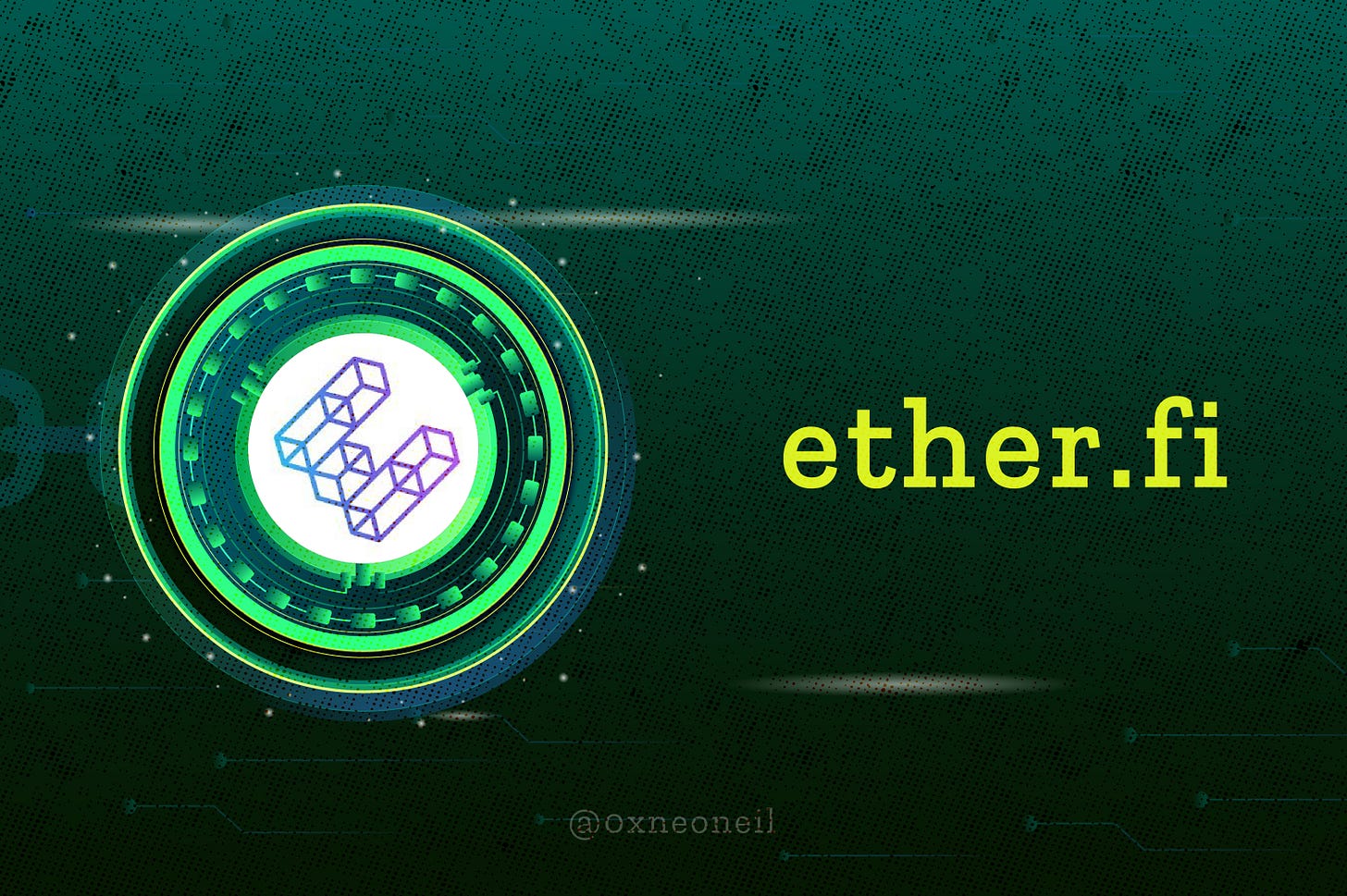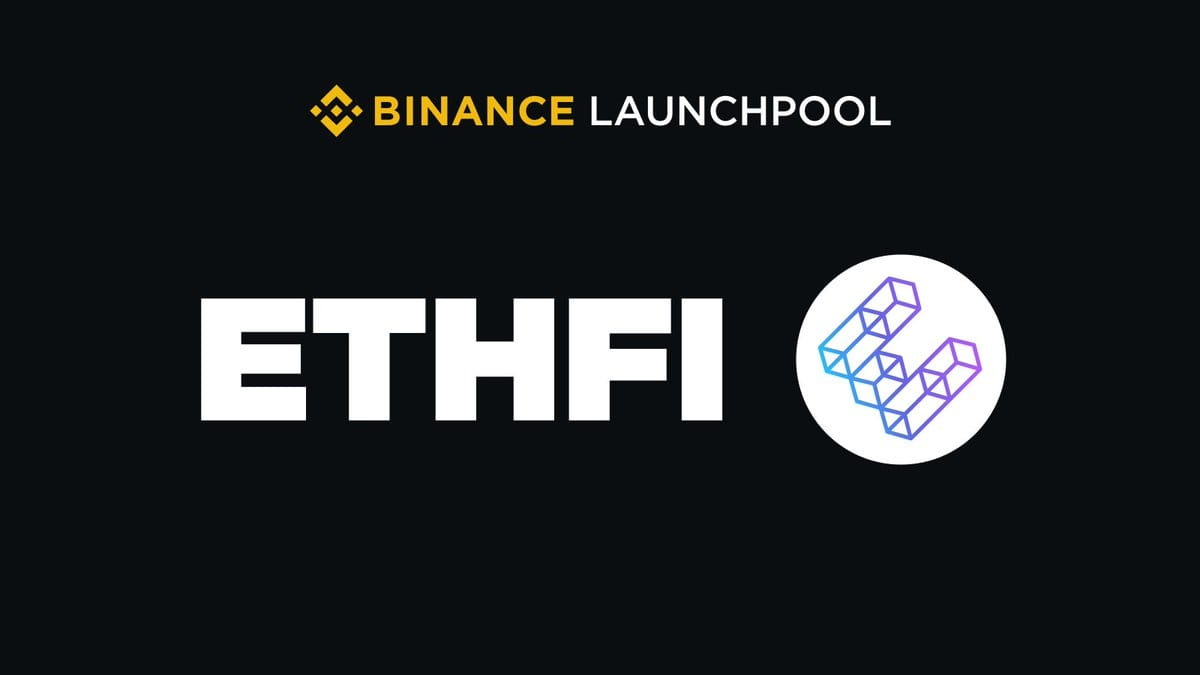What is ether.fi (ETHFI)? The first Liquid Restaking protocol on EigenLayer
Protocols within the native Liquid Restaking Protocol ecosystem are increasingly emerging with impressive strides, showcasing the project's growth potential alongside significant community interest.
1. What is ether.fi (ETHFI)?
Ether.fi, the 49th project on Binance Launchpool, is a liquid restaking protocol on Ethereum network, allowing users to stake ETH or various liquid staking tokens (such as stETH, cbETH, wBETH...) to receive eETH tokens at a 1:1 ratio. Additionally, ether.fi offers node service solutions to streamline the process and reduce costs associated with running nodes on Ethereum network.
Ether.fi will use the staked tokens to restake on EigenLayer, the largest restaking protocol currently available. As a result, users will receive rewards, including APR from staking and restaking, ether.fi points, and EigenLayer points.
With ether.fi, users can optimize capital efficiency through the utilities of eETH on other DeFi platforms such as staking, lending, borrowing, providing liquidity, and more.
2. Highlights of ether.fi
Ether.fi platform offers several notable features:
Intuitive Interface: ether.fi provides an intuitive staking interface with simple, user-friendly steps, enhancing the user experience of the platform.
Compatibility with Multiple DeFi Protocols: Recently, ether.fi has continuously collaborated with various DeFi protocols on the market to bring more applications to eETH holders. As a result, eETH can be used to provide liquidity for various DeFi protocols, including Pendle, Balancer, Curve, Maverick, and more.
Single-Token Liquidity Provision: In ether.fi, users can provide liquidity using only the eETH token to the Pendle pool, helping to avoid losses from impermanent loss. Subsequently, users will receive additional rewards from EigenLayer and ether.fi.
3. Features on ether.fi
In addition to some basic features like staking, DeFi, solo staker, and institutional staking, ether.fi also has its own platform dedicated to NFTs called ether.fan.
ether.fan is where users can stake ETH to mint Fan NFTs and receive additional APR over various timeframes, including 60 days, 90 days, and 120 days. The amount of ETH staked will also be transferred to the solo staker program on ether.fi.
3.1. Staking
Ether.fi protocol allows users to stake ETH and various liquid staking tokens (LST) to receive eETH in equivalent amounts (i.e., 1 ETH = 1 eETH). As mentioned earlier, ether.fi will use the tokens users have staked to participate in Native Restaking on the EigenLayer platform. As a result, users participating in ether.fi will receive accumulated profits from various sources, including:
APR from token staking, currently at 3.33%.
APR from token restaking, aimed at distributing restaking profits on EigenLayer between ether.fi and users.
Rewards from EigenLayer. All ether.fi points earned from restaking tokens on EigenLayer will be transferred back to users based on the assets they have staked on ether.fi. This means that users will also receive full benefits from EigenLayer points.
Rewards from ether.fi, also known as loyalty points. For every 0.001 ETH staked, users will receive 1 point per day. In the future, these points will be used in the project's decentralized governance mechanism. The formula for calculating ether.fi points is:
(staked ETH amount) * (1,000) * (number of days staked)
Additionally, after receiving eETH, users can also wrap it into weETH. Compared to eETH, this wrapped version may be supported on more DeFi protocols with more utilities such as lending, borrowing, trading..."
In terms of calculating reward points from EigenLayer and ether.fi, this is one of the new methods being widely used in the market at the current time to attract new users when the project has not yet launched its token.
Instead of hinting or spreading rumors about token airdrops, projects are implementing point calculation mechanisms to create curiosity and increase users' expectations about the benefits that rewards points bring to them, including the possibility of receiving airdropped tokens. This creates incentives for users to actively engage with the product.
In addition to ether.fi and EigenLayer, there are also other projects like Zeta, Drift, Blast... that are also implementing point systems for users on their platforms.
3.2. DeFi
DeFi feature serves as a hub for aggregating protocols and platforms that allow users to utilize eETH and wETH in various DeFi activities such as staking, providing liquidity, borrowing, and voting to receive bribes.
Using eETH and wETH on other platforms will also increase users' etherfi points. Depending on the protocol, the level of increase (boost) will vary, for example, 1x, 2x, 6x...
In this way, users not only receive staking rewards on ether.fi but can also maximize profits based on rewards from other platforms, including prominent names such as Pendle, Balancer, Curve, Gearbox, Gravita...
3.3. Solo Staker
Solo Staker allows users to register as Ethereum node operators without needing to stake ETH. This feature acts as a collaboration between ether.fi and registrants whereby:
Ether.fi utilizes ETH from those who have already staked on the platform and provides additional software and technical support. As a result, ether.fi operates a validator node on Ethereum and utilizes Distributed Validator Technology (DVT*) to ensure the system's decentralization.
Users possess the necessary hardware and internet connection. They simply need to register to become a member of ether.fi's DVT system to participate in the transaction validation process on the Ethereum network and receive rewards.
*DVT (Distributed Validator Technology) is a technology that allows multiple parties to operate a validator node by splitting the validator's private key into multiple parts and distributing them among multiple parties for joint management and transaction verification signing.
To implement the Solo Staker program, ether.fi has collaborated with three projects in the staking infrastructure sector such as Obol Network, Avado, and dappnode.
3.4. Institutional Staking
Institutional Staking is a feature that allows organizations to participate in ether.fi's ETH Fund and stake large amounts of ETH to delegate node operation to the platform's partners, including Finoa, dappnode, DSRV, Chainnodes, Obol, NodeRun, Cosmostation, and A41.
The project also makes sure that Finoa, a European-based cryptocurrency asset management company, securely stores and manages tokens that organizations deposit into the ETH Fund. Additionally, the fund will undergo KYC and annual audits, and ether.fi will provide monthly reports on the fund's status to ensure transparency.
4. ETHFI Token Details
4.1. ETHFI Token Key Metrics
Token Name: ether.fi
Ticker: ETHFI
Blockchain: Ethereum
Token Standard: ERC-20
Contract: 0xfe0c30065b384f05761f15d0cc899d4f9f9cc0eb
Token type: utility and governance
Total Supply: 1,000,000,000 ETHFI
4.2. ETHFI Token Allocation
Investors & Advisors: 32.50% (equivalent to 325,000,000 ETHFI)
DAO Treasury: 27.24% (equivalent to 272,400,000 ETHFI)
Team: 23.26% (equivalent to 232,600,000 ETHFI)
Airdrop: 11.00% (equivalent to 110,000,000 ETHFI)
Liquidity: 3.00% (equivalent to 30,000,000 ETHFI)
Binance Launchpool: 2.00% (equivalent to 20,000,000 ETHFI)
Protocol Guild: 1.00% (equivalent to 10,000,000 ETHFI)
4.3. ETHFI token release schedule
4.4. ETHFI token sale
Binance Launchpool officially sold ETHFI tokens with a total pool of 20,000,000 ETHFI for 2 stake token pairs: BNB and FDUSD, on March 14, 2023.
Stake BNB: 16,000,000 ETHFI in rewards (80%)
Stake FDUSD: 4,000,000 ETHFI in rewards (20%)
5. Roadmap
Phase 1: Delegated Staking
Release ether.fi on desktop
Enable delegation through auction mechanism
Withdraw staking rewards and unstaked ETH
Transferable (T-NFT) and Bond (B-NFT) ether.fi NFTs
ether.fi protocol treasury contract
Phase 2: Liquidity Pool and eETH
Integrate Oracle for validator node information
Release eETH
Integrate liquidity pools
Phase 3: Node Services
Integrate automatic restaking and DAO governance model
Integrate Distributed Validator Technology
Develop ether.fi infrastructure services
6. Project Team, Investors and Partners of ETHFI
6.1. Team
Ether.fi project team consists of numerous experts in the technology field, prominently including:
Mike Silagadze: Founder and CEO, previously held the position of Founder and CEO at Top Hat. Holds a BSc from the University of Waterloo.
Chuck Morris: Vice President and Project Technical Lead. He has been involved in the crypto market and technical team development since 2018.
Rok Kopp: Director of Customer Relations, with over 10 years of experience in Sales & Marketing.
6.2. Investors
As of the current date, ether.fi has completed two funding rounds totaling $32.3 million USD, including:
February 28, 2023: Raised $5.3 million USD led by Chapter One and North Island Ventures, with participation from other investors such as Arrington XRP Capital, Maelstrom, Version One, Node Capital, Purpose Investments.
February 28, 2024 - Series A Round: Raised $27 million USD led by CoinFund and Bullish, with participation from other investors such as ConsenSys, Arrington XRP Capital, OKX Ventures.
6.3. Partners
At the present time, ether.fi has partnered with several prominent projects in the market, such as Maverick, Gravita, Pendle...
Of particular note is the collaborative relationship between ether.fi and EigenLayer, which has enabled the platform to provide users with a more diverse range of liquidity pools while enhancing the project's security through technologies from EigenLayer.
7. Closing thoughts
Etherfi is a DeFi protocol that allows users to stake assets to provide liquidity built on Ethereum and other blockchains. Here, users staking assets retain control of their security keys within the protocol safely and without interference from centralized services. In Etherfi, the community can also register for node services to further enhance potential returns for users.
What about your thoughts? If you want to know further about it, don’t hesitate to share it with us! 😀
This post is for educational purposes only. All materials I used were the different reference sources. Hope you like and follow us and feel free to reach out to us if there is an exchange of information. Cheers! 🍻
#Etherfi #ETHFI #LSD #Ethereum #BinanceLaunchpool














